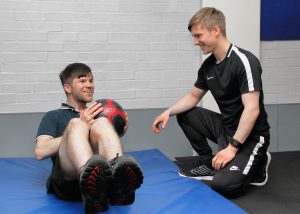The Beginners Beginning – Basic Training Structure
So you think that you have what it takes to stand up to bad eating habits, and to fight for your fitness?
Well this is Basic Training ladies; this is where we part the men from the mice, and the wolves from the sheep. Now drop and give me twenty!
Drill sergeant aside, the basic principles of training are far from a military operation, so you have nothing to worry about when stepping into the gym for the first time.
You can easily split each workout into five simple sections, and generally in the following order:
- Warm Up
- Cardiovascular Training
- Resistance Training
- Core Training
- Cool Down
This can vary, but essentially, it must contain a warm up, some form of training, and a cool down. By doing this it keeps your workout safe and focused on your goals.
As a beginner you will want to do some cardio to either focus on developing your cardiovascular fitness or burn calories. You would then do some form of weights session to target particular muscles of interest. Following this you would finish with some core training before cooling down.
Now to break it down:
The Warm up:
When warming up you want to gradually introduce your body to exercise, generally with some light cardio and/or body weight exercises that are not too taxing or isolate muscles. We want nice big movements to get your blood pumping. This will supply your muscles with energy and reawaken them from their day to day active rest; this generally takes about three to five consecutive minutes.
You will also want to include some light stretching, or body weight exercises that use a full range of movement (such as a squat) so that you loosen yourself up and become more supple, allowing you to use your muscles at a wider range than at rest. Do not over stretch though, this should only be a dynamic stretch to improve mobility. Trying to increase your flexibility here can put you at risk of injury.
Now, some people are eager to skip this as they see it as a waste of time. Think of a sheet of ice, it is firm and tense, and if you try to force it to move it will shatter. However, if you were to heat it up, the water can move fluidly, it is adaptable, and can be manipulated to do as you want with both speed and strength. Water can flow, or it can crash. Be water my friend.
Virtual high five for those who got the reference.
Cardio:
Cardiovascular training is exactly how it sounds; it targets your heart and lungs. It forces you into a nice healthy sweat as you develop your fitness in terms of overall endurance. This type of training will typically involve a treadmill, rower, cross trainer, or a bike. However, as you become more advanced, cardio can be included within your resistance training, or using cardio based exercises such as burpees and squat thrusts.
Your cardio session is usually performed before you do anything else as your muscles will not feel as tired. If you want to try and push through the exhaustion and soreness having just completed your weights, then that is absolutely fine, it just trains your body in a different way by increasing the intensity.
Resistance:
You are probably picturing some form of grotesque steroid inflated beast throwing around 50kg
dumbbells. I assure you though, that everyone should be taking part in some form of resistance training. Even for those looking to decrease their body fat, lifting a few kilograms will help to build muscle, therefore increasing your basal metabolic rate. This means that you burn more calories during the day, even when you are doing nothing.
How’s that for convincing?
So resistance training is for everyone. With this you can either tone, develop power, or increase mass. It can be done by either performing body weight exercises (calisthenics), using resistance machines (advised for beginners), or some form of free weights.
Core:
I am uncertain as to why core is separated from the rest of
your workout as it can be easily included within your resistance. You even have to use resistance based training. For most though, it is easier to have a section of their programme dedicated to it.
At this point you are probably asking what your core is. The easiest answer is your abs and back, but it is essentially every muscle that attaches to your spine. Naturally, this is a lot of muscle to be worked, so people typically ignore the back and include this within their normal routine. By doing this they can then tailor their core workout purely for their abs.
However, if you have not completed any back exercises, or would like to further stabilise your trunk, then you can work your back here as well.
A word of caution to you though, the core is what is keeping you stable and sturdy during all of your exercises prior to this. So make sure that they are before, otherwise a beginner would struggle to control the movement, which may put them at risk of injury.
For beginners you are most likely going to start with body weight exercises to build an enduring and stable core. Eventually, you can include weights and machines to develop this further.
The Cool Down:
As the polar opposite to the Warm Up, the Cool Down is essential for a safe decrease in heart rate and effort level to get your body used to regular use. It is also the time to stretch off the muscles you have been using so that you can flush out any build up of lactic acid. Naturally, this is the convenient time to develop your flexibility if you wish to do so.
Similar to the Warm up, this should take about 5 minutes. Feel free to go for longer though, just gradually decrease the intensity as you go or once you are done.
Now that you are enlightened to the basic structure of your workout, you need to fill it.
I’m not going to tell you how though. If I was, this article would never end, and I am sure you are tired of me rambling on already. The most important thing from today is that you know how to do your Warm Up and Cool Down. At least then you can begin safely, and experiment with different pieces of equipment.
The next couple of blogs I am going to dedicate to Cardio and Resistance training. Following this you will know what techniques you can use and what results you will receive from them. This will then help you to decide what techniques are right for you based upon the goals that you have already set.
Watch my videos on Youtube – EmpoweringPT videos on Youtube.
Become Empowered Today! Call 0750 333 6773 or email James Edwards.


